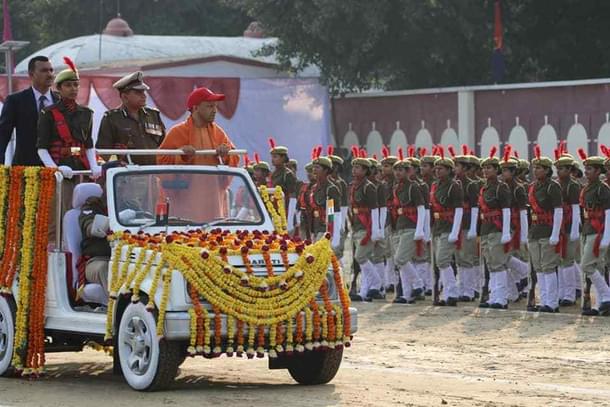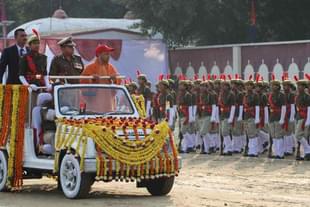Magazine
3 Years Of Yogi Adityanath As CM: How UP Police Has Become A Force To Be Feared
Vikas Saraswat
Apr 07, 2020, 12:30 PM | Updated 12:30 PM IST
Save & read from anywhere!
Bookmark stories for easy access on any device or the Swarajya app.


Inaugurating the office of the newly-created police commissionerate in Noida recently, Uttar Pradesh Chief Minister Yogi Adityanath made a telling comment. He said that “UP cops are now not found resting on cots”.
This simple quip succinctly conveyed the change in Uttar Pradesh Police which has been brought about by the Chief Minister. The transformation in UP Police, since Adityanath took over the reins three years back, has been one of the greatest Indian administrative success stories in recent times.
From being notoriously inefficient and corrupt, it now rates among the most responsive, people-friendly and at the same time dreaded among criminals, police force in India.
After coming to power in March 2017, Chief Minister Adityanath took improvement in policing as an urgency.
Bypassing several others, Adityanath picked 1983 batch Indian Police Service (IPS) officer Om Prakash Singh for the post of Director General of Police (DGP). An officer with a hands-on approach, Singh proved to be just what the doctor ordered for both UP Police and law and order in the state.
Under a no-nonsense Chief Minister and a new boss, UP Police, in no time, went chasing the criminals all guns blazing. Record number of encounters, which DGP Singh preferred calling engagements rather than encounters, took some toll on the force also.
However, relentless efforts with several young IPS officers being given charge of most troublesome districts, ended up setting panic amongst criminals and restoring confidence towards police in public.
But despite a substantial drop in crime rate, the Adityanath government, instead of resting on its laurels, committed itself to bringing institutional changes in the state police.
With a second batch of 49,568 recruits joining the training last winter, the police force has added about one lakh new cops in the last one-and-a-half years. The number includes recruitment to Provincial Armed Constabulary and 4,621 sub inspectors of police.
All the eight police training centres in Moradabad, Sitapur, Gorakhpur, Unnao, Sultanpur, Meerut, Jalaun and Mirzapur are booked up to December 2021. Other than these centres, minor training centres at Police Lines in 31 districts are also teeming with under-trainees.
The saturation of training facilities in the state hasn't deterred the administration and many new recruits have been sent to places as far as Avadi in Tamil Nadu for training. Besides the scale, the two phase recruitment has also been notable for absolute transparency and zero corruption.
Other than the large scale recruitments, the state is investing heavily in constructing new barracks, hostels, training centres and police stations. The acute housing problem for police personnel is also being addressed and quarters are being constructed throughout the state.
With a record 11.5 per cent increase in the allocation, Rs 27,286.69 crore has been sanctioned for police department in the 2020-21 state budget. This increase is in line with the last two budgets.
The state's push for better policing is not limited to infrastructure building and recruitments alone. It seeks to change the organisational behaviour and public perception of police.
The department is working hard not only to gain the trust of citizens but also make the police people-friendly. Extensive foot patrolling and daily visits to different police stations by senior superintendents of police have revitalised the force.
With a quick to react Twitter handle and collaboration with alert civilians at different platforms, UP Police has built up a strong social media outreach.
The department is regularly conducting contact programmes with students and commoners from different fields. In a novel gesture, police parties in some places have started greeting morning walkers in the parks.
These gestures coupled with the newly-launched citizen services app which facilitates in tasks like filing online complaints, tenant and employee verification, protest and procession requests and information on police station limits comes as a great relief to the citizens.
Structural changes within the department like introduction of commissionarates in Noida and Lucknow are expected to make the decision making smooth and fast.
Similarly, the integrated 112 helpline which deals with crime complaints, fire brigades and ambulance requests on one number itself will save time as essentially all three emergencies, might need a unified nodal point at times.
A dedicated call centre at Lucknow which is manned by the cops themselves ensures beatwise compliance by police personnel and feedback from complainants.
However, the major transformation in policing owes to the political will of the Adityanath government. Under the Bharatiya Janata Party rule, not only has the blatant political patronage to crime stopped, interference and lobbying by party workers in police stations and beats are largely absent.
If on one hand there is motivation in the form of praise for good work by cops, a number of erring policeman have also been taken to task.
In Gorakhpur and Varanasi zones alone, 27 and 20 policemen have been terminated so far. Similar dismissals have been made in rest of the six zones but exact figures for the same were not available at the time of writing this story. A total of 51 officers, including seven Provincial Police Service (PPS) officers have been compulsorily retired for inefficiency and corruption.
UP Police under Adityanath has also adopted a matter-of-fact approach towards communal goondaism and violence. It's stern handling of anti-Citizenship Amendment Act violence stopped the situation from spiraling out of control. Hindu festivities and processions, particularly Kanwar yatras, which used to be the target of communal mobs are being observed freely with fanfare.
For a ‘BIMARU’ state like Uttar Pradesh, which has suffered crime and chaos for long, policing has social as well as economic consequences. Besides revamped infrastructure, improved law and order is also imperative for the economic development of the state. Adityanath knows it too well.
That is why he is taking policing as seriously as expanding the expressway length and ramping up power supply. Adityanath knows that investor confidence cannot be won unless the law and order situation is good in the state.
During the 2018 Investor Summit, he assured the participants that his government will take good care of law and order. And the monk politician, on his part, has acted solemnly on his promise.





